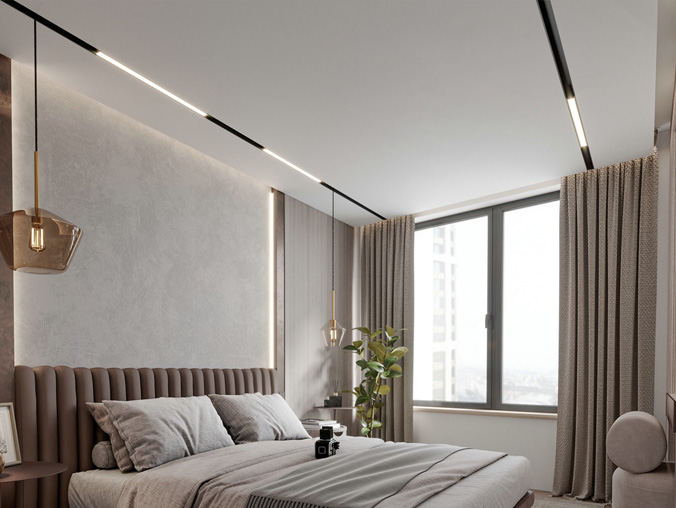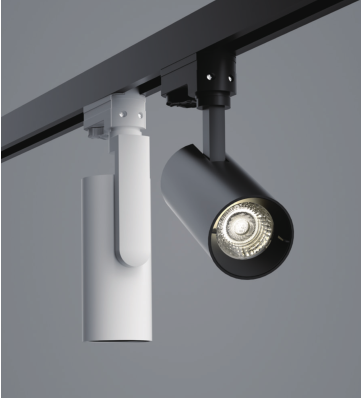

Whether the irradiation direction of downlight ceiling (ceiling-mounted downlights) can be adjusted after installation depends on its structural design: fixed downlight ceiling (e.g., most flush downlights) has a fixed beam angle and cannot be adjusted, while adjustable models (e.g., tiltable round recessed downlight) support 15°–45° angle adjustment—this is achieved through a “rotatable lamp body + flexible bracket” design. Premium adjustable downlight ceiling like IMIGY’s tiltable models not only adapt to diverse lighting needs (e.g., highlighting wall art or adjusting task lighting) but also pair seamlessly with Magnet Track Light systems such as Combo Track Lights and Uranus Track Light for layered, flexible lighting. Below is a breakdown of adjustment feasibility, our products’ advantages, and practical tips.
1. Two Types of Downlight Ceiling: Fixed vs. Adjustable
a. Fixed Downlight Ceiling (No Direction Adjustment)
Typical models: Most flush downlights and basic round recessed downlight (beam angle fixed at 90°–120°). Their lamp bodies are integrated with the housing—after installation, the irradiation direction is fixed (usually downward for ambient lighting). Suitable for spaces needing uniform brightness (e.g., hallways), but lacks flexibility for targeted lighting.

b. Adjustable Downlight Ceiling (Direction Adjustment Supported)
Structural design: IMIGY’s adjustable round recessed downlight features a hinge-style bracket between the lamp body and housing. The lamp body can tilt 15°–45° upward/sideward and rotate 360° horizontally—no tools needed, just gently push the lamp body to adjust the direction. For example, tilt it 30° to highlight a painting or adjust it to the countertop for task lighting.
Brightness compatibility: The adjustable models retain the same brightness as fixed ones (e.g., 10W, 800lm)—direction adjustment doesn’t affect light output, unlike cheap adjustable models that dim when tilted.
2. IMIGY Products’ Adjustment Advantages & Synergy with Track Lights
a. Adjustable Round Recessed Downlight & Combo Track Lights
Scene collaboration: Use adjustable round recessed downlight (tilted to highlight wall art) in living rooms and pair with Combo Track Lights (magnetic heads adjusted to sofa areas). Combo’s 360° rotatable heads + the downlight’s tilt function create a “dual-flexible” lighting system—easily switch between ambient, accent, and task lighting.
Installation harmony: Both the adjustable downlight (75mm–100mm opening) and Combo Track Lights (1m/2m modules) fit standard ceiling holes. No extra drilling is needed when combining them, reducing ceiling damage and installation time.

b. Adjustable Round Recessed Downlight & Uranus Track Light
Commercial application: In retail stores, pair adjustable round recessed downlight (tilted to highlight product displays) with Uranus Track Light (high-brightness heads focused on shelves). Uranus’ stable track sliding + the downlight’s direction adjustment ensure all products are properly illuminated, boosting display appeal.
Durability: The downlight’s hinge bracket uses stainless steel components—resists rust and wear (common in plastic brackets) even after 500+ adjustments. Combined with Uranus’ aluminum alloy track, the system maintains flexibility for long-term commercial use (12+ hours daily).
3. Practical Tips for Using Adjustable Downlight Ceiling
a. Adjustment Scenarios
Highlighting decor: Tilt the adjustable round recessed downlight 20°–30° toward wall art or photo frames—avoid over-tilting (>45°), which may expose the lamp body and cause glare.
Task lighting: In kitchens, adjust the downlight to tilt 15° toward the countertop—ensures sufficient brightness for food prep, complementing Combo Track Lights’ ambient glow.
b. Installation & Maintenance Tips
Ceiling fit: Install the adjustable downlight in a flat ceiling—uneven surfaces may restrict tilt range. Use a level to check ceiling flatness before installation.
Regular checks: Every 6 months, gently wiggle the lamp body to ensure the hinge bracket is tight—loose brackets (common in cheap models) may cause the direction to shift on its own.
4. Mistakes to Avoid
Don’t Over-Tilt: Tilting the adjustable downlight beyond 45° may strain the hinge bracket, leading to permanent damage. Follow the 15°–45° recommended range.
Don’t Mix Incompatible Sizes: Using an adjustable downlight with a 120mm opening (for large spaces) in a small bedroom (≤10㎡) causes over-illumination—choose 75mm–85mm models for small areas, matching Uranus Track Light’s small-module options.
Don’t Ignore Compatibility with Track Lights: Pairing non-dimmable adjustable downlights with dimmable Magnet Track Light (e.g., Combo) creates brightness inconsistency—ensure both are dimmable for synchronized control.
downlight ceiling can support irradiation direction adjustment if you choose adjustable models (e.g., IMIGY’s tiltable round recessed downlight). These models outperform fixed flush downlights in flexibility, adapting to diverse lighting needs while pairing seamlessly with Magnet Track Light systems like Combo Track Lights and Uranus Track Light. Whether you’re decorating a residential living room (needing accent lighting) or a commercial retail store (requiring display lighting), our adjustable downlight ceiling and track lights work together to create a versatile, user-friendly lighting system. Contact us to get personalized recommendations—we’ll help you select the right adjustable downlight and coordinate it with track lights based on your space size and lighting goals.
It is recommended that you upgrade the latest browser
 Chrome
Chrome Firefox
Firefox Edge
Edge